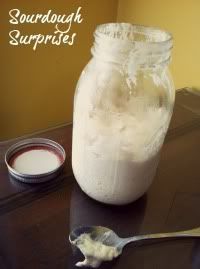Our starters take a lot of work, and many have been with us for a while. They are living organisms, and after a while they start to feel like pets or part of the family. Many people even name theirs (mine is named Felix). So when your starter suddenly starts not performing well, we want to fix things as soon as we can!
Your starter isn't just a mixture of flour and water, but actually a rather complex and dynamic ecosystem of microorganisms. It doesn't take much to throw it out of balance. But thankfully, starters are also fairly resilient things, and it is fairly easy to revive them back to health. I am going to try and keep things as simple as I can here, without getting into the more technical and scientific explanations (although I am really itching to do a post on that!)
Your Starter has a Layer of Blackish Water on Top
This liquid layer is called hooch. This is a naturally occurring alcohol that is produced when your sourdough starter has run out of food and needs to be fed immediately! You can kind of think of this as a waste product, and you should pour it off before you feed your starter. If you are getting this liquid often, it means you really should feed your starter more often! This layer of hooch actually causes the starter to drown, because the carbohydrates underneath can't get any air.
Your Starter Smells like Alcohol
When your starter isn't fed often enough, it is common for an alcohol smell to develop. This happens when the starter begins to consume discarded yeast as well as its own waste. Start feeding your starter more regularly, and your starter will return to its normal smell. If you need help remembering when to feed your starter, make a note on your calendar!
Your Starter Smells Like Vinegar
Guess, what? This is totally normal. The vinegar smells comes from the acetic acid in your starter. As the bacteria in your starter eat through the carbohydrates you have fed it, they produce the vinegar smell. This mostly happens when you change the type of flour you are feeding your starter. Continue feeding!
*Notes on smells. Different starters smell different, depending on the type and quality of flour that you are feeding it. Normal smells range anywhere from alcohol, vinegar, dirty socks, overripe fruit, beer, and sometimes even nail polish if it needs fed. It can be pungent and strong, it can burn your nose, and it can stink. But it should never smell like rotten cheese or moldy meat.
As you feed and continue to use your starter, you should become familiar with how it smells. You should know how it smells when it needs feeding and after you have fed it. When you cook, you continually taste so that you can adjust the seasonings. Sourdough starters work similarly, you should be continually smelling your starter so that you can adjust feedings as necessary. One of the first clues that something is going wrong with your starter is how it smells, so be aware!
Your Starter is Crusty
If you keep your starter at a lower hydration rate, this problem can arise. This happens when it has been neglected and not fed. Remove the crusty part and feed your starter.
Your Starter is Moldy or Discolored
This is fairly uncommon, but it occasionally happens, and is usually caused by one of two things. Either your starter/container/utensil was contaminated with soap or food reside during a feeding, or your yeast has become weakened due to skipped or improper feedings. Some people feel comfortable pulling out a tablespoon or so of starter that isn't moldy and trying to save it. However, we feel its probably safest and healthiest to just throw it out (sorry!) and start over. This would be a good time to revive some
dehydrated starter you have stored. When in doubt, Throw it out!
Your Starter is Sluggish
Generally speaking, this could be because of temperature. At colder temperatures, the microbes in your starter are sleepier. That is why we store in the fridge in between use. Because they tend to be sleepier, they take longer to activate. Reversely, if your starter is warm, it moves faster. The ideal temperature for your starter is 70 Degrees F.
Remedy Your Problems
Generally speaking, the best way to revive a sick starter is by feeding it.
- Keep it Clean - Transfer your starter into a clean bowl or measuring cup so you can thoroughly wash the "home" container for your starter. Make sure you use very clean bowls, spoons, and measuring cups, and that you wash your hands well before each feeding. Just because starters are fermented items does not mean they can handle bacteria.
- Check your Container - Make sure it is kept reasonably clean, remove any dried gunk from the lip of the container so you get a good seal with the lid. You also want to make sure that your container is twice the size of your starter, so that you have as much air in your container as you do starter. This will allow your starter to have enough oxygen to breathe.
- Feed it - Feed your starter as you normally would, using good quality flour and clean, cool water. Cover and allow to stay on the counter for several days. Continue feeding every 12 hours for several days, until your starter has returned to its normal, healthy, bubbly self.
I hope you have found this post to be helpful!
**Note: I tried to simplify a lot of the science of sourdough starters, so you could understand how to care for a starter without necessarily understanding a lot of the technical science behind it. Are you interested in a more technical post that explains the science behind how a starter works? If so, please leave a comment and let me know!














